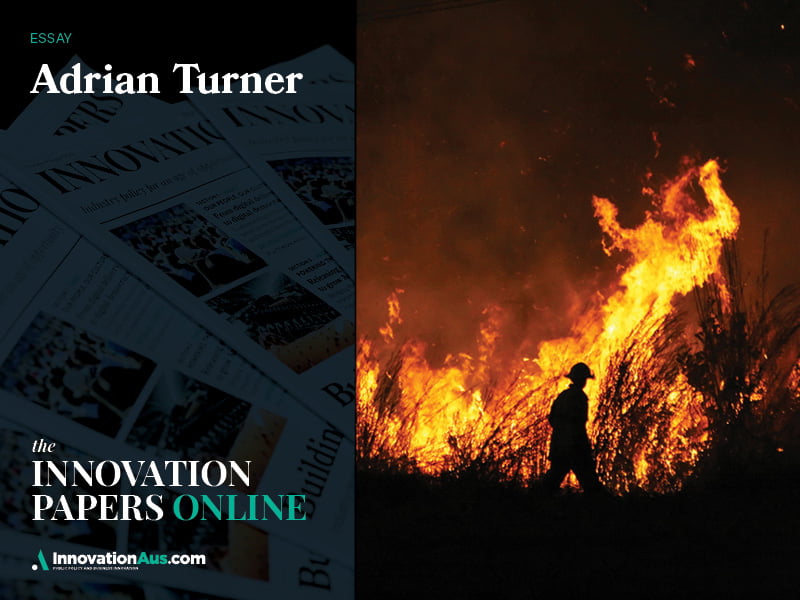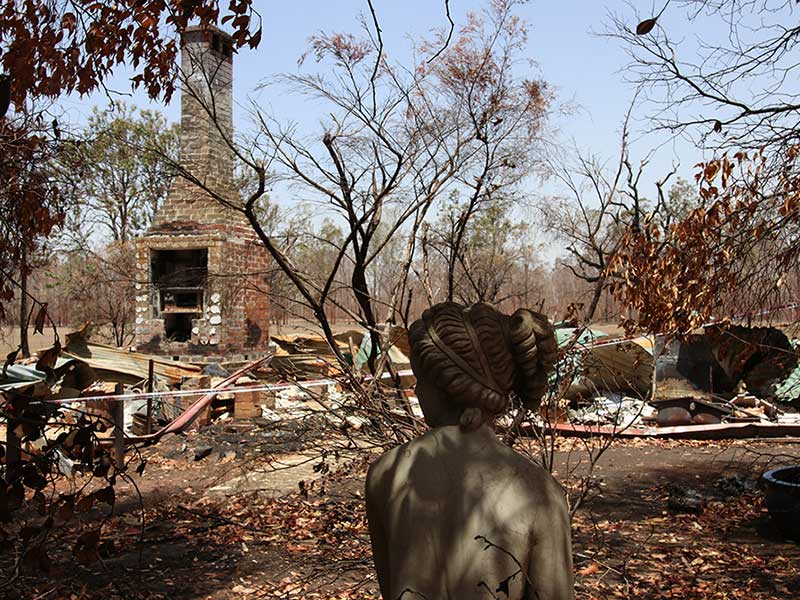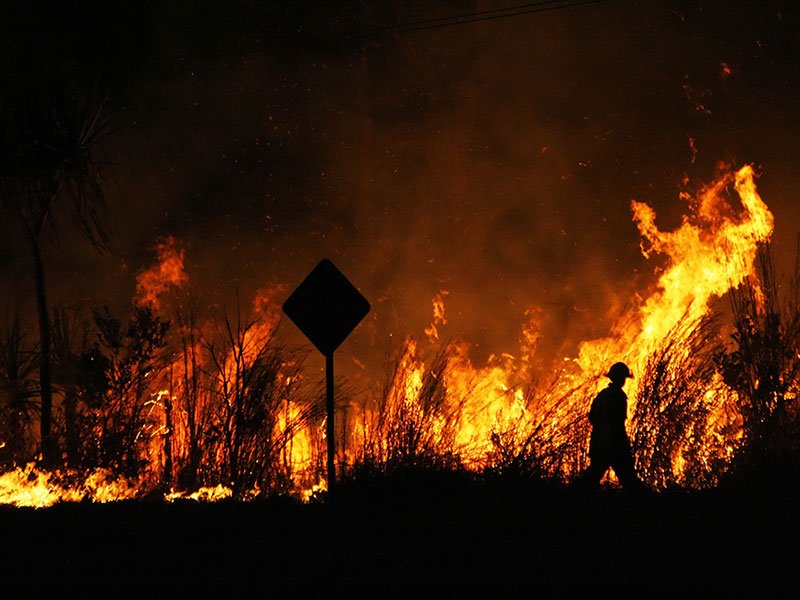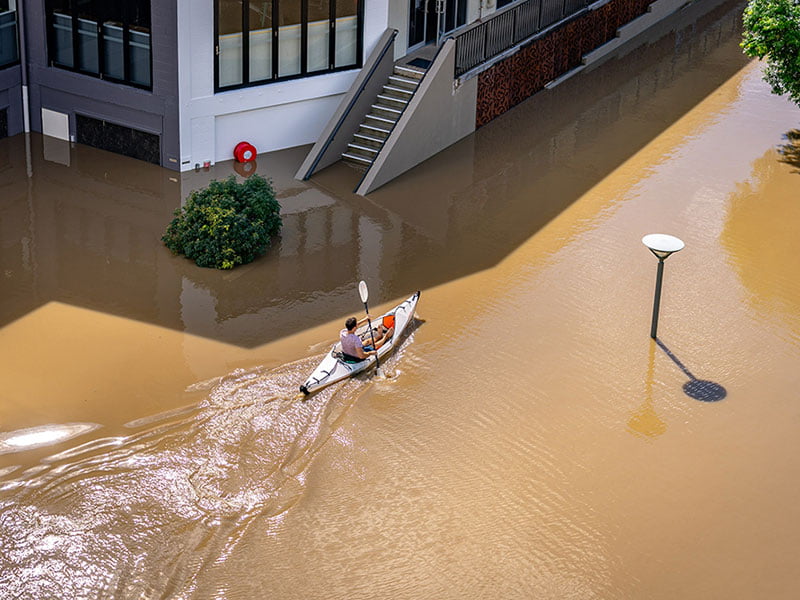Prevention is better than cure: it’s a familiar idiom that expresses a simple truth yet its logic is often ignored. Sometimes the effort required now to address future natural threats seems too great, even when the cost of inaction could be greater.
If the past few years have taught us anything, however, it is that climate-related disasters can no longer be brushed aside in this way. Their growing impact is simply too far-reaching.
We cannot prevent disasters entirely, nor can we alter human nature, but we can take steps to dramatically reduce their consequences and learn to adapt to the threats we face.
The way we deal with disasters in Australia is out of balance. Some 97 per cent of all disaster spending in Australia occurs after the event and only 3 per cent on preparation and resilience.1 This is both ineffective and unsustainable.
To effectively reduce the harm caused by fire and floods in the future, spending needs to be around one third for each phase in the disaster management lifecycle: Response, Recovery and Resilience.

The Minderoo Foundation Fire and Flood Resilience initiative is working with government, corporates, community, emergency services, philanthropies and the research sector on solutions to increase our capacity to prepare for fires and floods that we know are coming.
We are confident new technologies can help tip the balance further in favour of prevention, saving the lives, livelihoods, homes and belongings, and the landscapes we all cherish. Many of these tools exist now. Scaled up and correctly applied, the difference they can make is huge.
It is not just about technology. The challenge we face is complex, bound up in a web of diverse interests, relationships and demands. It is something we refer to as a systems-level problem, and its impacts are felt throughout the disaster management cycle.
Systems-level problems are extremely difficult to solve but there are frameworks we can use to help us. What is needed is a change of mindset and a willingness to work together across all stakeholder groups to enable positive change.
A disaster waiting to happen
In Australia, the average annual cost of natural disasters is currently estimated at $38 billion.2 There is no doubt spending on response and recovery is necessary – disasters are happening in quick succession over a compressed period of time.
Preventing displacement and homelessness is one critical issue that needs to be addressed. Minderoo Foundation is proud to pioneer solutions and programs in this category, such as temporary housing pods that have helped 345 families stay on their land and begin rebuilding their lives following disasters.
Our experience working in this field has shown that authorities are underprepared for the surge in demand for housing that will inevitably occur after a major disaster that damages or destroys homes.
To address this, we are calling for a purpose-built, national temporary accommodation asset register to address future natural disaster situations that is based on community needs and geography. This would provide different types of accommodation and related services that could be leased for a term by government to ensure stock is available for communities across the country into the future.
Measures like this are a simple example of how we can get ahead of the curve but there are also much more fundamental steps that need to be taken. Currently our focus on Response and Recovery means only 3 per cent of disaster spending is left for measures that will increase preparedness and resilience – measures that could stop families losing their homes in the first place, not to mention their loved ones. The balance is wrong. To employ another familiar idiom, it is shutting the gate after the horse has bolted.
It is also puzzling because, as a nation, we are more than capable of committing significant resources to address potential future threats. Every year Australia spends around 2 per cent of its total economic output on defence, a figure approaching $50 billion.
Given we are not currently engaged in any conflict, this spending can be seen as 100 per cent preparatory. Recently the Australian Government announced a range of expensive new defence mega-projects, including a fleet of nuclear submarines and the development of hypersonic missiles.
These will cost many billions of dollars and take years of careful planning. It could be decades before they enter service and, when they finally do, everyone involved hopes they will never actually need to be used in battle. Thankfully, there is a good chance they will not.

Future challenge
Sadly, no such favourable odds exist when it comes to natural disasters. Bitter experience tells us they will happen again and, what is more, we know they will happen more often and with greater costs and consequences.
Globally, the UN’s World Meteorological Organisation estimates natural disasters have increased five-fold since 1970, accounting for 45 per cent of reported deaths and 74 per cent of economic losses.3 There is nothing hypothetical about the dangers we face.
As Prime Minister Anthony Albanese pointed out in July, 70 per cent of the world’s natural disasters occur in our region, the Indo-Pacific. During 2019, more than 90 million people in the region were affected.4
In Australia, annual spending on disasters is expected to almost double by 2060 to $73 billion.5 The devastating bushfires of 2019-2020 burned over 17 million hectares of our country and destroyed more than 3,000 homes.
They caused 33 deaths during the immediate crisis and subsequently led to almost 450 more due to smoke inhalation.6
Successive floods in the years since have meant some communities are still in the recovery phase as the next disaster hits, compounding social, environmental and economic impacts.
This year, we have seen bushfire-affected parts of NSW suffering increased flooding because they are less able to hold water in the catchment, with debris washed into the waterways creating additional drainage issues.
Australia has long been an attractive destination for foreign investment due to our infrastructure, highly skilled workforce, consistent economic growth, our location and strong governance systems.
It has the fourteenth highest amount of foreign investment in the world, and this has grown by 5 per cent over the past five years.7 By December 2021, foreign economies had a total of $4.1 trillion invested in Australia. A more disaster proof Australia is more likely to attract increased foreign investment.
Why is it that we are willing to invest so much of our national budget to prepare for national security threats that will probably never happen when we cannot take sensible measures upfront to protect ourselves from something we know definitely will?
Part of the answer lies in the dual role our defence spending plays. On the one hand it equips us better to cope with a potentially catastrophic event, on the other it also diminishes the likelihood of that event occurring.
This is the so-called deterrence effect: knowing we are well prepared should make an enemy less likely to attack.
I want to argue something like this mutually reinforcing logic can be made to operate in case of natural threats. First though, I want to explore another example of our human tendency to avoid short-term sacrifices, even when they may deliver longer-term gains: preventative health.
The information problem
Australia’s record in this area is even worse in percentage terms than natural disasters. Estimates place our investment in preventative health at or below 2 per cent of the total healthcare spend.8
That is despite a range of preventable conditions accounting for an estimated 83 per cent of premature deaths9 and $27 billion in annual spending.10 This compares to the total Commonwealth healthcare commitment in the last Budget of $132 billion.
The imbalance is clear, and it seems irrational, but is it?
Granted we know a certain number of people will develop chronic disease every year and a certain number will die from it. We also have a rough idea of the cohorts at risk. Nevertheless, our information is far from perfect: we cannot be certain exactly who will be struck down and who will not.
Neither can we be completely sure preventative measures prescribed will be effective. Some will benefit but others may not. Prevention is better than cure but only if we can be sure the cure will work.
Natural disasters are a bit like this. We know they are coming, we know where the least resilient flood and fire prone regions are, but we don’t know exactly when these events will happen.
Beyond the basic precautions, any additional efforts we make as individuals could turn out to be unnecessary at best, futile or even counterproductive at worst. For example, flood levees may protect one area and direct flood waters to another, devastating the next area.
As risks compound, governments, Non-Governmental Organisations (NGO) and emergency services face additional uncertainties imposed by the lengthening fire season, la nina and jostling priorities. How do we spread spending across competing priorities? Imperfect information acts as a drag on our decision making and the motivation to prepare.
In healthcare, personalised medicine is the next frontier of treatment. Aided by improved diagnostic techniques and clearer understanding of individual variations that affect patient outcomes, clinicians aim to create healthcare plans that better meet specific needs.11
This could dramatically increase the effective application of preventative medicine by matching correct preventative interventions with the correct patient.
At the Minderoo Foundation we are working with partners to develop tools and frameworks that do the same thing. We are mapping the risk of bushfire onto specific landscapes, for example, in the same way genetic analysis is being used to predict an individual’s risk of developing certain cancers.
Our work with climate technology company Salo Services is another case in point. Salo uses artificial intelligence to processes information from satellite and aerial images, converting it to high-quality maps that allow authorities to assess fuel loads and pinpoint where fire risks are greatest. Resources can then be devoted to reducing the fuel load before a bushfire ever breaks out.

Addressing the gap
Early fire detection could reduce bushfire costs in Australia by up to $8.2 billion over the next 30 years.12 Authorities currently rely on triple zero calls for a large component of fires that are detected.
Powerful forms of satellite technology could enable the automated detection of fires anywhere in Australia within an hour, which is the aim of Minderoo Foundation’s Fire Shield Mission.
It could be hugely significant given CSIRO estimates a 10-minute delay in detection can see a fire’s area grow by up to 1500m2.13 Early warning will allow fire fighters to assess the threat and pre-position assets in the early stages, vastly improving their chances of preventing an isolated outbreak becoming a full-blown disaster.
As part of this, Minderoo Foundation is advocating for natural disasters to be part of the National Space Mission for Earth Observation, emphasising the applicability of space-based earth observation for disaster risk management as well as other applications such as remote environmental and resource management, including water quality measurement, land cover mapping and ocean health monitoring.14
This civil space mission would be led by the Australian Space Agency and the National Emergency Management, Resilience and Recovery Agency with non-government support provided by the Minderoo Foundation to fast-track progress through engagement across non-government sectors.
Government stakeholder guidance would be provided by state and territory emergency service agencies and Department of Defence, Geoscience Australia, Bureau of Meteorology and the CSIRO. Space industry and research communities also have an important role to play in this mission.
The United States and Australia have long shared firefighting expertise and resources in response to our fire seasons leveraging the hot and dry seasons which take place at different times in the year. Climate change is contributing towards longer fire seasons and more dangerous conditions.15
There are strong parallels between the recent catastrophic fire events including drought, parched landscapes, high temperatures, prolonged heatwaves, and dry lightning storms.
Our two fire seasons when combined offer 12 months of continual learning and piloting to solve the problems that need to be tackled to lift resilience, which could lead to accelerated shared outcomes between us.
There is an opportunity to partner internationally on space-based fire detection capabilities, which could detect and share information to assist with more rapidly responding to fires globally.
Reframing the landscape
It is not just about technology. The frameworks we use to guide our actions are just as important. Finding more accurate ways to value our natural environment, for example, can help us direct resources more effectively to protecting it.
Natural capital16 refers to the natural assets within landscapes such as trees, waterways, soil, biodiversity and other natural resources. Nature can become an investible asset which can direct capital into nature positive value creation.
According to the Australian Bureau of Statistics, Australia’s natural capital is worth $6.5trillion, so much is at stake to lose through natural disasters.
As reforestation emerges as a primary vehicle to generate carbon credits, we must also lift those forests’ resilience to natural hazards, otherwise the credits should be valued at a lower level.
Minderoo Foundation is working with Accounting for Nature and the Burnett Mary Regional Group on a world-first natural capital pilot totalling 5 million hectares to create a proof-of-concept natural capital regional account.
Part of the Healthy Landscapes Mission, which aims to halve the hazard exposure of Australia’s 50 most hazard prone regions by 2025, the project is a test bed to measure the impact of initiatives such as indigenous land management on reducing the risk of fire or flood in the landscape.
Measuring and accounting for the unique ecological and agricultural values of Queensland’s Burnett Mary region will set the region up for success to enhance resilience to climate and nature-related risks.
Financial incentives towards natural capital projects that build resilience in landscapes are something the Minderoo Foundation would like to see carried out by government, corporates and philanthropies together.
Since we cannot risk losing these natural assets through fires or floods, we need to create new investment steams to reverse the destruction of nature.
New amendments to the Critical Infrastructure Protection Act are another positive step. These will boost resilience by the increasing information flow between industry and government, helping us better understand and manage threats to assets that are essential to Australia’s economic stability, defence or national security.
These kinds of tools, obligations and incentives utilise better information to improve decision making and, ultimately, boost preparedness.
A new model for innovation
To make the most of them, Australia needs a joined-up, national approach that is still sensitive to the nuance of local communities and landscapes.
This cannot be done in isolation, it takes collaboration and input from stakeholders across government, business, communities research and NGOs.
We believe system-level problems like disaster management can only be solved by something we call the mission model.
The mission model operates in a very specific way. First it sets out to clearly define the problem and the system change that needs to be achieved in quantifiable terms.
Using first order principles, it breaks the problem down to the most fundamental building blocks and proceeds to define the projects that need to be delivered across the system to fix it in a coordinated way with stakeholders.
Outcomes are then measured. This leads to parts of the system solving problems concurrently, and when this happens in aggregate, the system problem gets achieved.
Minderoo Foundation is advocating for a National Missions Program to help make that possible.
It would operate in a similar way to the Mission Oriented Innovation and Industrial Strategy in the United Kingdom, which seeks to reframe the way government partners with the private sector and NGOs to solve big problems.
With a direct line of support from the Prime Minister, we see it operating across the economy to address system-wide issues that reduce our preparedness, applying a multidisciplinary approach to help drive exactly the kind of innovation described in this essay.
The same approach could also be used to address other pressing challenges such as food security, water management and cyber security.
A National Missions Program would allow us to develop a common operating picture, an agreed way of looking at national risks, a common language and a common set of principles to decide what is most at risk and what is most worth saving.

A community of practice
In disaster management, currently grants are not based on risk assessments, which can mean the communities that need assistance most often miss out.
If we are going to invest nationally to lift resilience, we need a data-driven national operating picture of the communities that are the most exposed and vulnerable to hazards and emergency events, and the specific risks and needs inherent to them.
And we need to ground truth this evidence base with the communities involved. This evidence base can be used as a mechanism to prioritise and target support in all its forms; infrastructure, financial, social services to the communities who would benefit the most from this support. It can also help to baseline and measure the impact of the support provided to them.
The Minderoo Foundation’s 50 Resilient Communities Mission aims to lift the resilience of Australia’s communities most exposed and vulnerable to hazards and emergencies, to be on par with the most resilient.
Our Resilience Index is a decision support tool that focuses the direction of resources to the most at risk communities. It is based on 45 indicators covering hazard exposure, social vulnerability and community capacity, covering 57,000 Statistical Area 1 (200-700 households) nationally.
Use of this Index as a decision support tool in government would allow us to assess and allocate funding for projects on a needs basis, against clear criteria rather than simply catering to whoever asks the loudest.
Through our collaborative model, we convene community led resilience planning activities across Australia’s highest risk regions using the Resilient Communities Framework which helps practitioners and community members identify risks and prioritise interventions.
Disaster resilience plans are developed with community leaders, based on this locally led understanding of risks, hazards and priorities.
Disaster preparedness activity is then delivered in communities from the ground-up through community led projects, additional investment, and through a new national volunteering initiative, the Australian Resilience Corps (The Corps).
The Corps activates local community members who volunteer to build resilience in their community, at times where emergency events are not occurring.
Minderoo Foundation is calling on the government to implement the above approach in Australia’s 50 most vulnerable communities, ahead of national scaling. We believe community engagement and community led action is at the very heart of resilience.
In the insurance context, new ways of conceiving the value and ownership of data such as those encapsulated in the Consumer Data Right could improve community resilience by increasing competition in the insurance market, paving the way for new products that incentivise consumers to do more to protect their own assets.
Changing the paradigm
Last year the Federal Government pledged to spend $700 million over five years on climate change and disaster resilience in the Pacific region, through its overseas aid budget.17
If it makes sense in the Pacific, it makes sense in Australia. Just this month we saw again how lack of preparedness forced the evacuation of residents in Australia’s biggest city, Sydney, including some who have endured three major floods this year alone.18
It is estimated there have been 57 formal public inquiries into bushfires in Australia since 1939. Many of their recommendations have never been implemented. This cannot continue.
In this post-industrial era, we are already beginning to see consecutive, concurrent and compound risks emerging as one disaster bleeds into the next, spreading damage ever further across our networked economy and communities.
Leaders must come together around the big multi-disciplinary challenges and support development of a new innovation model that boosts preparedness and resilience – the National Missions Program.
As with Defence, spending on disaster resilience comes with a dual benefit. Not only will it reduce the severity of natural disasters when they occur, saving lives and money, it will also make those disasters less likely by nurturing healthier, less fuel dense landscapes and better functioning water catchments.
The improved capability we develop in areas such as earth observation can also be applied to other areas of the economy – improving the performance of agriculture during periods of drought, for example.
Importantly, communities we make more resilient to disaster will also be more resistant to other events such as future pandemics, or mental health crises.
Ultimately, improved preparedness will also contribute to the reductions in carbon emissions that will lessen climate change and, over time will reduce the threat future generations face. As any hospital patient will tell you, prevention truly is better than cure.
Adrian Turner is an influential Australian tech entrepreneur who spent 18 years in Silicon Valley building businesses before returning to Australia in 2015. Adrian is Chief Executive Officer at the Minderoo Foundation Fire & Flood Resilience Initiative, and was recently appointed Deputy Chair of Prezzee, a conditional payments company dubbed the newest billion-dollar tech ‘unicorn.’ Adrian was the founding CEO at CSIRO’s Data61, the team that led the development of the national AI roadmap, AI ethics framework, standards advisory work for consumer data rights and open banking.
Footnotes
- https://www.pc.gov.au/inquiries/completed/disaster-funding/report/disaster-funding-volume1.pdf
- https://www2.deloitte.com/au/en/pages/economics/articles/building-australias-natural-disaster-resilience.html
- https://public.wmo.int/en/media/press-release/weather-related-disasters-increase-over-past-50-years-causing-more-damage-fewer
- https://www.afr.com/politics/federal/anthony-albanese-s-popularity-dips-poll-20220712-p5b0vs
- https://www2.deloitte.com/au/en/pages/economics/articles/building-australias-natural-disaster-resilience.html
- https://blog.csiro.au/bushfires-linked-climate-change/#:~:text=The%20Black%20Summer%20forest%20fires,But%20were%20these%20fires%20unprecedented%3F
- https://www.dfat.gov.au/trade/resources/investment-statistics/statistics-on-who-invests-in-australia
- https://www.phaiwa.org.au/public-health-expenditure/
- https://www.phaiwa.org.au/public-health-expenditure/
- https://apo.org.au/node/94416
- https://ebm.bmj.com/content/25/4/125
- https://csrm.cass.anu.edu.au/sites/default/files/docs/2020/9/Measuring_the_economic_impact_of_early_bushfire_detection.pdf
- https://www.bushfirecrc.com/sites/default/files/news/fire-detection-public-report.pdf
- https://www.industry.gov.au/sites/default/files/January%202022/document/advancing_space_earth_observation_from_space_roadmap_2021-20303.pdf
- https://climate.nasa.gov/news/2315/study-fire-seasons-getting-longer-more-frequent/
- https://www.abs.gov.au/AUSSTATS/abs@.nsf/Latestproducts/4655.0Main%20
- https://www.dfat.gov.au/about-us/publications/png-australias-commitment-to-strengthening-climate-and-disaster-resilience-in-the-pacific
- https://www.smh.com.au/environment/weather/we-might-not-move-back-flood-affected-residents-ponder-future-after-third-flooding-event-in-a-year-20220704-p5ayz2.html
Do you know more? Contact James Riley via Email.

